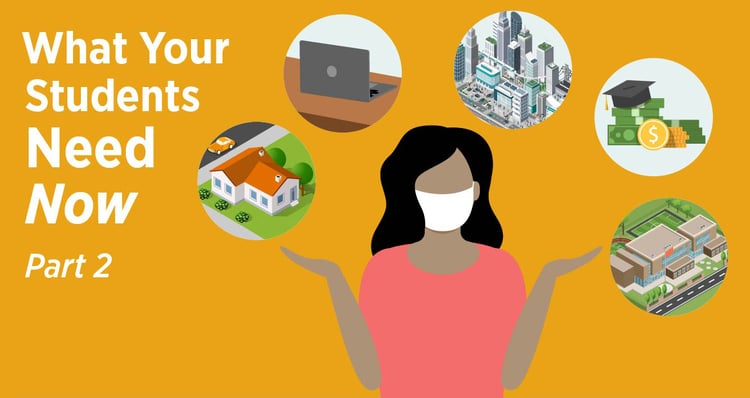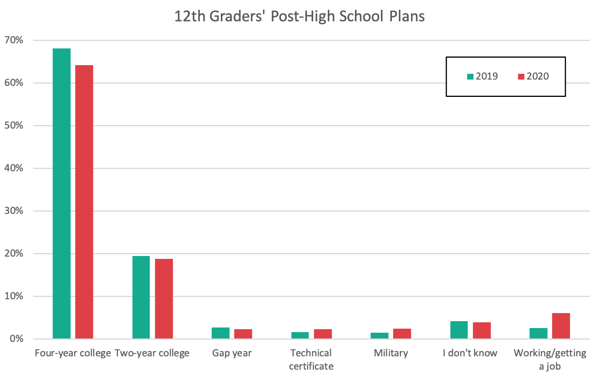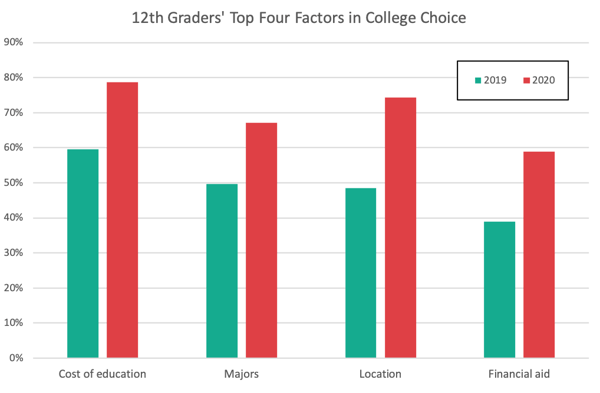
Last week, we put your prospective students’ SOS call on your radar.
Today, we’re going to show you exactly how to answer that call.
(Those of you reading to the end of this post, we can feel your thanks. You're welcome).
From the Naviance data we covered in Part 1 of this series, one thing is clear: your digital strategy and shifts in messaging are crucial right now. With COVID-19 agitating the waters, many students (domestic and international) are lost at sea in the college search and decision-making process. It’s your job to throw them all a life jacket. Metaphor alert: that life jacket is: engaging, informative, customized digital marketing content.
Students will be receptive to your messaging this fall. They want your guidance. Do you know what to say?
With the help of more Naviance data and our own market research, this week’s post is all about the how, where, and what of your digital marketing messaging in this unfamiliar time of COVID-19.
Our goal: helping you create messaging that will guide your prospects through those choppy waters…right to the safe harbor of your institution. Don't worry, we’re done with the ocean metaphors now.
Read on for the digital tools and key topics your prospects need this fall and how to incorporate them into your admissions and enrollment strategy.
Remember this statistic from last week's post?
In the March-June period of this year, Naviance saw a 25% increase vs. 2019 in students’ use of their SuperMatch® service – a uniquely calculated score that provides students with their “fit” at a certain institution. (see link to that post above)
The takeaway: with in-person visits, most in-person college fairs, and access to familiar and valuable advising resources off the table this year, students have increasingly turned to data as a substitute for personal guidance on the crucial intangibles of the college decision-making process. They are looking for answers anywhere they can get them.
What this means for your marketing
This period of new student enrollment ambiguity is a huge opportunity to provide prospects with those usual human touch points through your digital channels. Here are some thought-starters. We can help you implement all of this (and more.)
- Use your institution's newfound strengths in online teaching to offer your prospects things like sample courses and lectures. Give them a taste of the academic experience at your institution.
- Informational webinars with staff and current students are low hanging fruit as well. Add a alumni who present well (and have a great job in an attractive company). Know that you are competing with many other institutions doing the same thing. Put time and thought into your presentation. Think: informative and engaging fun. Talking heads without spirit and energy will win you no points with this audience.
- Give students an inside look at the spirit of campus life through organic video content and virtual tours. Short form video players are key here. Be sure to give these bits of content from your student helpers a guiding hand so they stay on message (but still have that wacky quality that prompts shares).
- If you really want to take things up a notch, look to peer-to-peer advising platforms such as Unibuddy for seamless, integrated solutions that bring prospects and current students together. If you’ve read our peer-to-peer eBook, you know just how powerful these student advising conversations can be.
Conversation Starters
The bottom line: prospective students are seeking information and engaging, personal digital content. But what exactly do they want to see and learn from your institution?
In last week's Naviance data, we reviewed the responses of 11th and 12th grade students to several questions related to major milestones in their college search process during their 11th grade year. We offered up a very insightful table (missed it? see the link to last week's post above).
So, here's this week's insightful table. A snapshot of data that focuses exclusively on 12th grade respondents and what they are considering for their immediate futures.


Source: Inside Higher Ed
The first bar chart tells us things are relatively on track in the student planning process.
The second bar chart -- that's where the criteria by which the student plans take shape get really interesting. Note those major 2020 increases in importance of the top four college choice factors.
Let's take a closer look at what is on students’ minds right now:
- Cost & Financial Aid: The percentage of 12th grade students reporting that “cost of education” was a top factor in their college decision jumped from 59.7% in 2019 to a whopping 78.7% in 2020. “Financial aid” also jumped from 38.9% to 58.9%. While cost of education also surpassed majors and location as a top factor in college choice pre-COVID, that gap has widened now. Think about how you are messaging your tuition and financing options. Lead with this. And be sensitive to the family economics driving this Naviance data: significant unemployment and losses of summer revenue for students put the value of education expense top of mind. Ignore this reality at your peril.
- Employment & Work Opportunities: While students’ post-high school plans still include two-year and four-year colleges in similar numbers pre- and post-COVID, the percentage of Naviance students who report “working/getting a job” as part of their plans jumped to 6.0% this year (up from 2.5% in 2019.) Does your institution have incredible career services? A robust work-study program? Strong industry connections and job placements? Assure students that they can find opportunities to earn and further their career goals while completing their studies. Give examples: show, don't tell.
- Location: The percentage of Naviance students reporting “location” as a top factor in their college choice was 74.4% in 2020 (up from 48.6% in 2019) and edged out “majors” as the second most important factor after cost of education. In a post-virus world, proximity to family, quality health care, and population density are now key influencers in the decision-making process. What this means: hone your messaging around your location’s unique selling points. Remote, rural campus? Play up your social-distancing-friendly natural spaces – that fresh air! Located in an urban center? Highlight the easy access to world class healthcare and job opportunities. Important: with students’ willingness to travel at a low, having a robust recruitment strategy for students in your own backyard is now more important than ever. A larger proportion of students in your region are considering your institution than ever before. Segment your audiences and get each of them the information they need to evaluate your offering. More to come on this topic.
- Majors: After cost of education and location, majors are the top factor in students’ college choice, with 67.1% of Naviance students reporting that this was a top factor (up from 49.6% in 2019.) It is well-documented that students shift towards more career-oriented degrees when the job market is in a downturn. A recent study conducted by Remote Internships found that 28% of students initially set on their field of study are now considering a change in path in the wake of COVID-19. A particular highlight: 41% of students who were planning careers in NGOs are now considering other options. A push towards fields such as engineering, finance, business, economics, and healthcare is predicted as students set their sights on job stability and higher salaries in an uncertain future. Ensure you are highlighting the programs that students are actually seeking and, most importantly, tying those programs directly to job and salary outcomes.
We know there’s a lot on your plate as the new school year and the 2021 admission cycle kicks off. Our message to you is that all of this stuff is doable.
Prospective students are particularly receptive right now to learning more about your institution and what it can offer to prepare them for a secure future. In fact, now more than ever, they need your guidance and a look at your vibrant campus community, facemasks and all, to remind them that a fulfilling, worthwhile, “normal” higher education experience is still within their grasp. They want a future with opportunity -- something you can authentically and reliably deliver.
You just need the stand-out digital campaign that will bring these prospective students to YOUR website since every other institution is trying to do the same. And once you get them there, you need to be sure the user experience is competitive as well.
There’s an opportunity here to set your institution apart as a leader that puts students’ needs first. It’s time to focus on your unique value to your target audiences and communicate it clearly.
Need help identifying the unique needs of those target audiences? An extra set of hands to develop and execute that digital messaging? Be in touch. We’re here to help.



